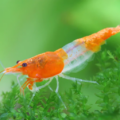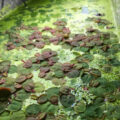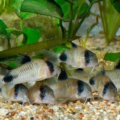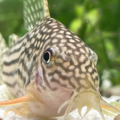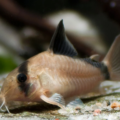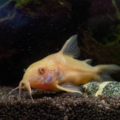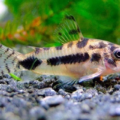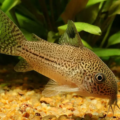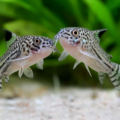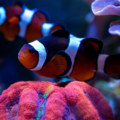Get the best care tips for preserving this Corydoras glowing orange scales and keeping them safe from incompatible tankmates. Come find out why this small bottom-dweller stands out as a centerpiece in a community of vibrant species.

Introduction
Whatever your reason for wanting this species in your aquarium is, it’s valid. They’re visually captivating, with bright golden-orange and black scales, and fun to have with their social personality.
Species from the Corydoras family are the best bottom-feeder fish for community tanks because of their hardy, cheerful, scavenging, and adaptable nature.
Read to the end for full details on caring for this golden-headed freshwater catfish. But first, let’s start with essential identification tips to distinguish Corydoras adolfoi from other Callichthyidae family species.
Author’s Note: Check out the 14 Types of Corydoras Catfish: A Guide to Hardy and Playful Freshwater Fish for our favorite Corydoras picks!
Identifying the Golden-headed Beauty of the Bottoms

Corydoras adolfoi is a small fish that grows up to 2.2 inches (5.5 cm) in maturity, so you can categorize it as a “big” nano fish. But its size isn’t the selling point for aquarists of all levels. Hobbyists love Adolfo’s Corydoras for their vibrant colors and bubbly personalities.
Color Patterns

Each Adolfo Corydoras has a creamy white or rare light pink base body and colorful highlights. They have golden scales on half their body, thick black stripes from the dorsal fin to the tail’s top, a black band across their face like a mask, and a bright orange spot between the black stripes.
Personality Traits and Unique Features
This tropical freshwater catfish also has whiskers around its mouth to search for food in substrates. It’s a social species that gets along with other compatible tank mates and loves swimming in groups.
Creating the Ideal Tank Setup for Adolfo’s Corydoras
Moving Adolfo’s Corydoras from their natural South American river basin to your home aquarium can be Challenging. But with the right freshwater catfish essentials, you can give your pets a great home away from home!
Tank Size & Grouping
Determining the minimum tank size and mates is the foundation for building the best setup for Adolfo’s Corydoras or other water dwellers. They need space and comfort in the tank where they’ll spend the rest of their lives.
So, get a 20-gallon aquarium for a group of six to ensure free movement and companionship.
Substrate & Decor
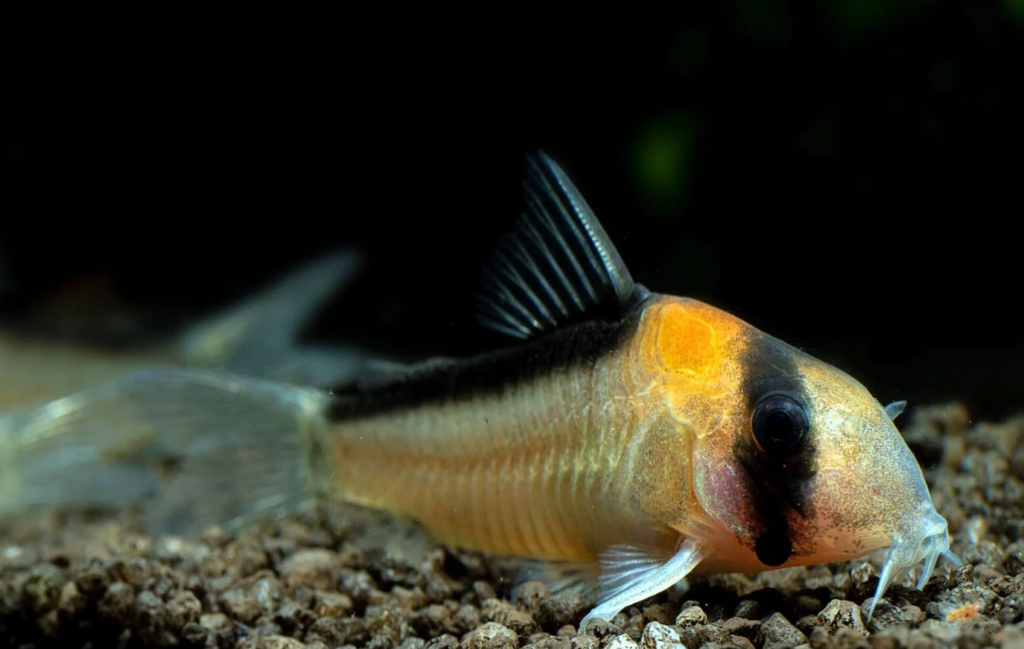
Use smooth substrates, like soft sand or rounded gravel, to protect barbels when digging for food. Then decorate the tank with pieces like driftwood, live plants, and smooth rocks to look like the Rio Negro river basin.
Examples of ideal decor include Amazon Swords, Cholla Wood, and dried Indian Almond Leaves.
Considering sand-sifting gobies for your aquarium? See this detailed post on their care and benefits.
Water Conditions
Water parameters for South American fish like Adolfo’s Corydoras are cool, slightly acidic, and soft to moderately hard. See the specifics below:
| Temperature | 72 – 79℉ |
| pH | 6.0 – 7.5 |
| Hardness | 2 – 12 dGH |
Filtration & Flow
Gentle filtration and moderate flow replicate their natural environment, which is safe for their small sizes. Keep the lighting dim by using live plants as shade or a low-light installation. Now, let’s discuss choosing the best tank mates.
Choosing the Best Tank Mates for Adolfo’s Corydoras
Adolfo’s Corydoras are peaceful freshwater community fish for community tanks, but don’t take their social nature for granted. Their interaction with other fish in the community and the environment depends on how comfortable they feel.
Schooling Instincts

This species thrives in groups of at least five other small or nano Corydoras species because it encourages them to school (swim in groups). Schooling helps them fulfil their social needs and stay cheerful, which keeps them healthy.
They’re also curious pets who’ll interact with the objects around them, making Adolfo Corydoras the best bottom-dwellers for planted tanks.
Best Tank Mates
Some compatible fish for Adolfo’s Corydoras to swim with include small, peaceful Corydoras like Bandit Corydoras, C. pygmaeus, C. hastatus, or other fish like tetras, rasboras, and dwarf cichlids.
Species to Avoid
Large, aggressive fish like Oscars, mid-sized cichlids, and Blowfish are incompatible because they can outcompete for resources or harm your pets by nipping their fins or eating them.
Feeding Adolfo’s Corydoras: The Key To a Balanced Diet

You’re probably wondering why you need a bottom-feeder nutrition guide for this scavenger. Only a balanced diet can provide optimal health and maintain a vibrant coloration.
Dietary Preferences
Although this species is an omnivore with preferences for leftovers in the substrates, they need varied nutrition for optimal health.
Best Foods
The best food for Adolfo’s Corydoras is high-quality sinking pellets filled with all the necessary nutrients. You can supplement the staple with live/frozen and plant-based meals like bloodworms, tubifex worms, and blanched vegetables.
For more on feeding your aquatic pets check out The Ultimate Guide to Fish Food: Pros and Cons & Best Choices!
Feeding Frequency
- Feed staples once or twice daily during dusk/dawn.
- Feed supplements once or twice weekly and treats once bi-weekly.
- Serve portions they can finish in 2 minutes.
- Remove uneaten food after 24 hours.
These guidelines on feeding schedules for freshwater catfish reduce the risk of overfeeding, malnutrition, and water contamination.
Breeding Adolfo’s Corydoras: How to Encourage Successful Spawning

Breeding Adolfo’s Corydoras successfully requires learning the necessary details, such as breeding behaviors, environmental conditions, and proper fry care.
Spawning Triggers
Scroll up to refresh your memory on this species’ ideal water parameters and diet. Now, let’s create spawning triggers with those conditions.
- Reduce the temperature by 2 – 3℉
- Feed a high protein diet for two weeks.
- Increase water flow to medium.
- Ensure proper aeration and filtration for pristine water.
Female breeders lay their eggs while collecting sperm from the males for fertilization in the T-position.
Egg Protection
After fertilization, the female C. adolfoi attaches the sticky eggs to a smooth surface, where they’ll stay until they hatch in 3 – 5 days. Freshwater fish egg care ensures your pets grow into healthy adults. Remove the adults or move the eggs to a separate tank to avoid them eating their vulnerable young.
Fry Rearing
Finally, when raising Corydoras fry, you must create a safe growing environment and provide adequate food for their healthy development. Start the fry with infusoria and liquid food until they grow mouths that can chew. Then, feed them crushed baby brine shrimp.
During this stage, make daily water changes to keep the quality pristine.
Health Management: Preventing Common Diseases in Adolfo’s Corydoras
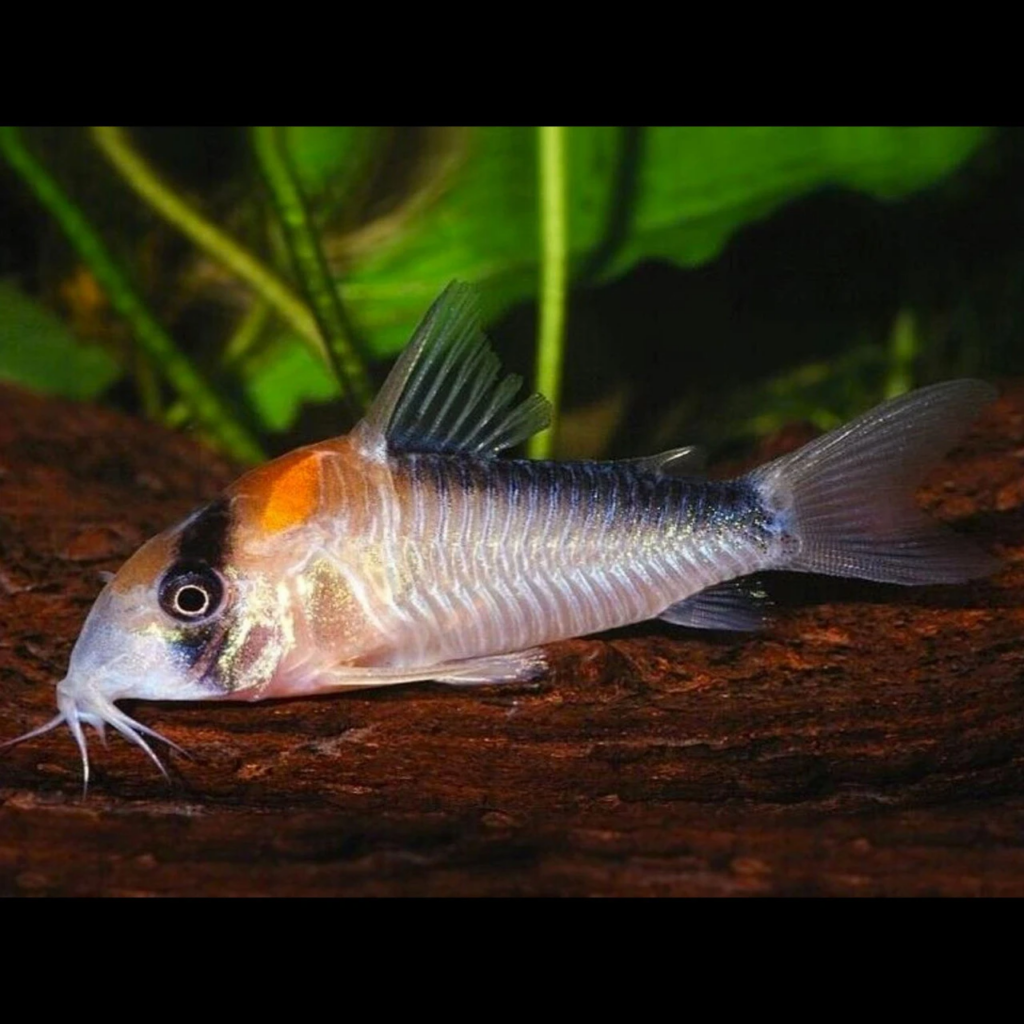
Maintaining a thriving school of Adolfo’s Corydoras depends on how well you administer daily care, as poor maintenance is the leading cause of the most common diseases.
Common Health Risks
Common health concerns for bottom-dwellers include barbel erosion while digging for food, fin rot, and fungal infections caused by poor water quality and stress.
Prevention Strategies
Adolfo’s Corydoras disease prevention practices include managing water quality, maintaining stable conditions, and ensuring proper nutrition. Scroll up for details.
Safe Treatment Methods
Fish illness treatment in aquariums with a vast community of species is challenging. Each species has unique features that make it sensitive to certain medications.
So, it’s best to quarantine affected fish for treatment and use non-harmful medications for sensitive fish.
Lifespan & Long-Term Care: Keeping Adolfo’s Corydoras Healthy for Years
The average Adolfo’s Corydoras lifespan is 5 – 8 years when you strengthen the key factors contributing to their long-term health. This guide has already detailed them, but here’s a summary.
Stable Water Conditions
Use a routine to make water changes because sudden fluctuations lead to stress. Check all parameters, from temperature to pH, hardness, and oxygenation.
High-Quality Diet
Varied feeding strengthens their immunity against bacterial diseases and keeps their armored scales vibrant. Some food classes are also mood stabilizers.
Routine Tank Maintenance
Providing weekly cleaning and behavioral monitoring tips is an investment in long-term care for freshwater fish. You’ll reduce the risks of environmental infections, and noticing abnormalities early helps you treat your pets ASAP before a disease becomes deadly.
Conclusion
As we wrap up this guide on keeping Adolfo’s Corydoras in a home aquarium, let’s review some tips to ensure you cover all ground. Why is the Corydoras family the best bottom-dweller for peaceful tanks?
- They have an eye-catching appearance.
- They’re easygoing
- They’re suitable for beginners and experienced aquarists alike.
This freshwater fish care guide, which includes nutrition and grouping tips, outlines the best practices for maximizing freshwater fish’s 5 – 8 year lifespan.
If you’re ready to take that bold step and commit to adding Adolfo Corydoras to your aquarium, now’s the time. We’d love to hear about your experience in the comment box below.

